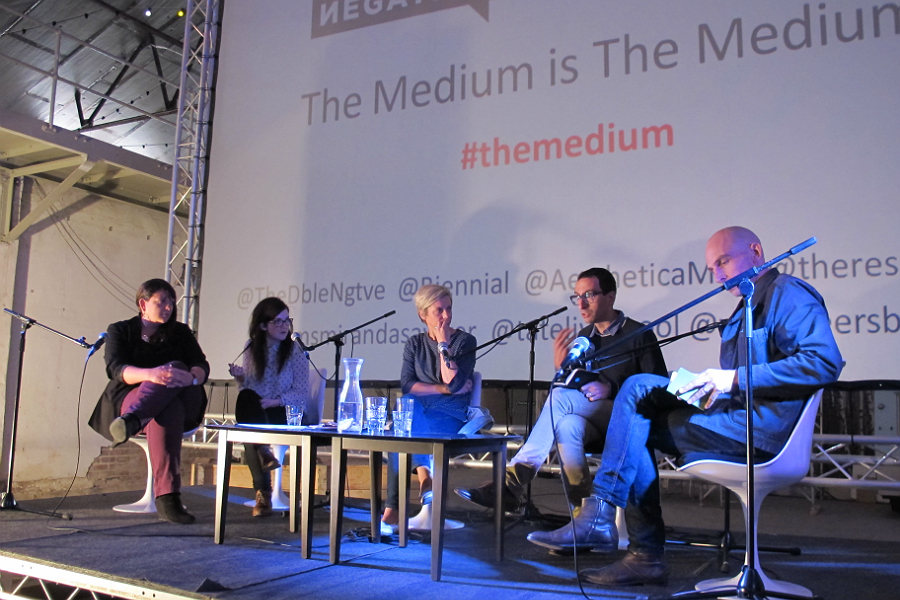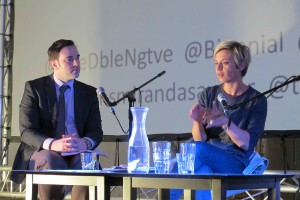The Medium is the Medium

It’s a question that’s been asked since the dawn of time, well blogging, but just where are the standards in journalism set now?
Getting on for a couple of weekends ago, I was at Lime Street Station to meet journalist, writer and broadcaster – and personal hero – Miranda Sawyer off the London train. No biggie like, just a typical Saturday afternoon!
It was for our event, The Medium is the Medium, part of the first weekend of the Biennial’s public programme. Set up to investigate the changing face of journalism in light of the post-internet landscape, the event featured guests who we hoped would tease out where the standards lie for today’s critics, whatever platform they operate from.
Obviously, no easy answer exists, which is why we’d invited a selection of speakers working in different ways in the medium. Cherie Federico, editor of Aesthetica Magazine, writer and lecturer (at Goldsmiths) Edgar Schmitz, new media maestro Rachael Jones, and Miranda Sawyer of course, who we saw as bridging the divide between finding success in both print and new media.
Cherie Federico was a great place to start. Establishing Aesthetica in 2003, she went straight into print rather than take her chances with a still developing internet, and has found that while embracing the blogging side of the industry, the magazine, published monthly, remains the mainstay of the brand. The place that the two worlds collide, says Federico, is interesting.
It didn’t take long to get into the thick of things. Many bloggers, suggested Federico, often mistake straight ‘criticism’ as counting as critical writing. “[critical writing] must play with the subject, create a dialogue throughout – it cannot criticise for the sake of it or just be gratuitous … it should create debate … if it’s too overt, too much like a rant – it achieves nothing…”
And therein lies the criticism (no pun intended) often lain at the door of the blogger – that a blog is a platform from which to be heard, when very often it would be to everybody’s benefit (including the blogger) if they’d just keep their opinion to themselves. Or at least put it differently. As with the old adage that everyone has a book in them, this doesn’t mean that other people would want to buy and read said book.
More than a crumb of encouragement was offered though. “Be enthusiastic and passionate about what you do, and write as much as you can”, she proffered, “[try] to get published elsewhere … establish your profile.”
Next to take the stage was Edgar Schmitz, who as well as lecturing at Goldsmiths, writes frequently for leading German language arts journal Kunstforum. Fascinatingly, Schmitz’s argument involved pointing out that we must relinquish our grip on the critic as God: ”The audience is perfectly capable of gathering information. Critical writing is not about educating people.” A contentious point, which could well induce squirms depending on your position.
He also pointed out to this end, very few people even declare themselves ‘critics’ per se, preferring the much more benign ‘writer’ as moniker: “the figure of the critic has long lost its appeal as a figure of identification, except of course in those instances where it can be appropriated, and where it can be made to embody the opposite of its historical authority.”
The point seemed to be that, at a time when the known landscape has shifted so significantly, there no longer exists the old hierarchies of knowledge to which the rest of us must demur. And if you cast yourself in the role of critic, neither does there exist the fear to question your opinion. Perhaps the democratising nature of the internet is a good thing after all?

Which led nicely to next speaker Rachael Jones. For Jones, a freelance writer used to writing in different contexts and for different platforms, the internet and blogging holds no fears. An expert tweeter, Jones was keen to point out that, whatever else the internet can be blamed for, the diluting of correct language isn’t one of them. Central to her argument was “that language evolves rapidly and constantly”. Easy to assert, but what about examples?
Jones had this covered with a sublime slide showing old – and unintelligible - telegram shorthand terms. If we wrote the book on ‘txt’ speak and as Jones calls them, ‘twitterlogisms’, we have nothing on people trying to find their way around excessive charges on telegrams. Let’s also not forget the @ originated as an accounting symbol (‘at the rate of’), appearing on typewriters from 1889.
It’s a good talk, laced with wit. It could have descended very quickly into novelty territory, but with Jones’ tight grip, it is rooted in the sense that, while things are appropriated and language is continually changing, adherence to good old fashioned grammar (Jones proudly describes herself as a ‘grammar fascist’) means that a good writer will always concentrate on writing well.
I end my day the way I began it, chatting to Miranda Sawyer. This time there just happened to be a stage, with us on it, and dozens of people watching. I comforted myself with the reality that people would be watching and listening to Sawyer rather than me. Along with the great anecdotes that come with a career writing about culture, Sawyer delivered some great advice. Asked about how she made her way into journalism (she had been studying, and hating, Law), Sawyer admitted “I have no qualifications other than I was obsessed with Smash Hits”.
It’s refreshing as it illustrates that even at a time when industry hierarchies were still very much entrenched, somebody could break in and do the thing they really wanted to do. We moved on and chatted about how a little later in her career, she found herself hanging out with artists and bands. This seemed the perfect time to ask about critical distance. How does one go about reviewing, sometimes poorly, the person they may well have been drinking with last night?
“It’s fine to be friends with an artist. Many artists are really likeable: charming, funny, original thinkers, great to get drunk with. But as a journalist, your loyalty is to your reader. Your job is to tell them about the work, or the person, and also – and this is really important – what you honestly think. There isn’t an artist out there that hasn’t made duff work. If it’s bad, you need to say why. Same also applies if it’s good. And if you end up falling out with the artist over that, then so what? It’s not your job to make friends with new and exciting people. That’s your life.”
For somebody working and writing in what is a relatively small city, this was one of the most salient points of the day. Liverpool’s art and music worlds are extremely incestuous, and you can always spot the review which you suspect has been written with that in mind. Sure, it’s not right; in fact, you’re doing nobody any favours in the long-run. It was a good place to end on, journalistic integrity.
And really, that fit well with some of the key threads of the day. No matter where different media take us, opinion has and will always be subjective. The trick for journalism and criticism is to retain a critical distance, and to write with balance and clarity. If something was bad or good, why? Readers, no matter how they arrive at a specific platform, will still by-and-large, gravitate to quality.
Liverpool Biennial continues until 25th November





